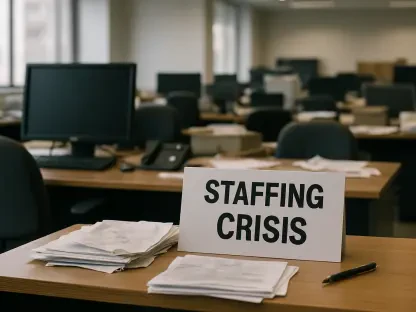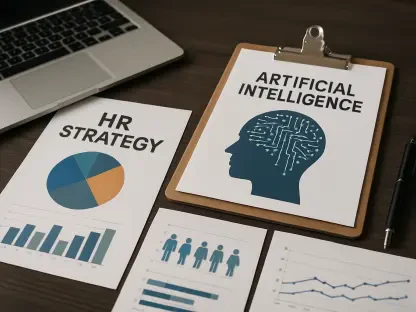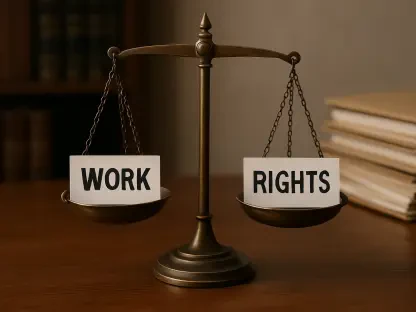What happens when the workplace, a space meant for growth and collaboration, becomes a source of fear and discomfort for employees? Sexual harassment remains a pervasive issue, affecting millions globally and undermining the very foundation of professional environments. With staggering numbers revealing that over half of women and a significant portion of men face such behavior at work, the urgency for action cannot be overstated. This feature delves into the critical role HR plays in tackling this challenge, exploring strategies to foster safety and respect while highlighting the real impact on individuals and organizations.
The Hidden Crisis in Modern Workplaces
The reality of sexual harassment in professional settings is alarming, with data from recent UK studies indicating that 52% of women and 20% of men have encountered it during their careers. Shockingly, nearly three-quarters of women refrain from reporting incidents due to fears of disbelief or retaliation. This silence perpetuates a cycle of harm, eroding trust and morale. Beyond personal tolls, businesses suffer from reduced productivity, higher turnover rates, and potential legal liabilities, making this a pressing concern for HR departments across all sectors.
The issue transcends industries, though certain environments—like those with stark power imbalances or customer-facing roles—report higher incidences. Conversely, sectors with stringent oversight often see fewer cases, but underreporting remains a universal barrier. HR must recognize this as not merely a compliance issue but a fundamental responsibility to safeguard employee well-being, ensuring that no one feels isolated or unprotected in their daily work life.
Defining the Problem: What Constitutes Harassment?
Understanding sexual harassment is the first step toward eradication. It encompasses a range of behaviors, from unwelcome physical contact and suggestive remarks to inappropriate digital messages and intrusive personal questions. Such actions create hostile environments, leaving victims feeling humiliated, degraded, or disengaged from their roles. HR teams need to ensure that employees at all levels grasp these definitions to prevent misunderstandings and normalize respectful interactions.
The impact on individuals can be profound, often leading to anxiety or withdrawal from professional opportunities. Certain workplace cultures, particularly in informal or high-pressure settings, exacerbate risks, making recognition of these patterns essential. Real-world data underscores the challenge, with only 24% of victims reporting incidents, highlighting a critical need for HR to bridge the gap between awareness and action through clear communication and education.
Voices of Authority: What Research and Experts Say
Evidence from credible sources paints a stark picture of the gap between policy and practice in addressing workplace harassment. Studies by organizations like the Equality and Human Rights Commission (EHRC) reveal that many employees distrust internal reporting mechanisms, fearing inaction or backlash. An expert from Acas recently noted, “Visible, enforceable policies are non-negotiable—without them, trust cannot be built.” This sentiment underscores the urgency for HR to prioritize transparency in handling complaints.
Anonymized accounts further illustrate the stakes. One employee shared how reporting harassment led to subtle retaliation from colleagues, eroding their confidence in the system. Such stories, paired with research showing persistent underreporting, emphasize that HR must go beyond drafting rules to actively demonstrate accountability. Building a culture where employees feel safe to speak up requires consistent, compassionate responses backed by data-driven processes.
HR’s Toolkit: Practical Steps to Drive Change
HR professionals hold the power to transform workplaces through targeted strategies. Developing clear anti-harassment policies is foundational—defining unacceptable behavior, outlining reporting procedures, and ensuring accessibility through digital platforms like HR software. These tools can centralize policy hubs, track acknowledgments, and maintain up-to-date guidelines, aligning with best practices recommended by bodies like the EHRC.
Beyond policies, fostering trust in reporting systems is vital. Offering confidential or anonymous options, training managers to handle disclosures empathetically, and maintaining digital audit trails for transparency can encourage victims to come forward. Additionally, regular, interactive training sessions—tracked via HR systems—reinforce behavioral expectations, while support mechanisms like counseling through Employee Assistance Programs (EAPs) and flexible work arrangements help victims recover without fear of stigma.
Finally, cultivating a culture of respect starts from recruitment and permeates performance reviews and daily interactions. Surveys to gauge employee perceptions of safety, paired with software to document feedback, enable HR to measure progress. By leveraging technology for training records, absence management, and secure storage of sensitive data, HR teams can shift from reactive responses to proactive prevention, ensuring measurable outcomes in creating inclusive environments.
Looking Back to Move Forward
Reflecting on the journey, HR departments have taken significant strides in recognizing sexual harassment as a critical workplace issue, driven by alarming statistics and personal testimonies that demanded action. The commitment to clear policies, trusted reporting channels, and ongoing training has laid a foundation for safer professional spaces. Yet, the challenge of underreporting and cultural barriers persists, reminding all stakeholders of the work still needed.
Moving ahead, HR is poised to lead with innovative tools and a renewed focus on empathy, ensuring that every employee feels valued and protected. Strengthening partnerships with external experts and adopting technology to streamline processes offers a path to sustained progress. The resolve to build workplaces rooted in respect has never been stronger, paving the way for lasting transformation.









